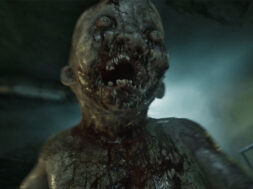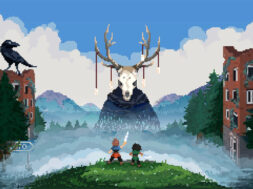The forest is a classic setting for horror. There’s something so ominous about exploring a landscape that’s so easy to get lost in and so easy to hide things in. There’s a very primal association with folklore that the setting has, instantly giving it a more mysterious feel without having to do much work. Darkwood throws you into the woods and takes advantage of these associations, forcing you to scrape to survive and escape the harsh environment.
In a revelation that shouldn’t have been a shock to me, survival mechanics meld perfectly into the horror genre, giving extra tension to routine actions. Knowing that you’re going to have to risk exploring dangerous areas in order to find supplies forces you into situations you would normally avoid and makes you play with a sense of urgency that encourages you to take more risks, which make for perfect conditions for a horror game.
Right off the bat, the game grabs you with its unique art style, presented from a top-down perspective. This isn’t a point of view you would normally associate with the genre, but they manage to make it scary through competent and consistent art direction. All of the objects on the screen are perfectly sized as to not be too big to dominate or too small to lose clarity, even when playing in handheld mode on Switch.

Developers Acid Wizard came up with a unique way to present the character’s perspective, giving the world a fog of war-like effect that is only revealed when the character’s cone of vision is pointed in that direction. Sometimes the world is even revealed to be different with the lights on, making for some startling discoveries without ever having to rely on cheap jump scares.
Creature designs are smartly simple, with just enough uncanniness to unsettle. Men wearing deer antlers, bodies that split vertically down the middle and several different wild animals are just a sample of the creatures you’ll find hiding in the woods. The animation also has a hand-drawn feel to it, breathing horrifying life into these designs.
To help amplify the mood, the game has exceptional sound design that keeps you on edge. The thwacks of your shovel hitting an enemy, the pop of your gun and the growls of the dogs chasing you all have a more naturalistic sound rather than the “sound effect” style we’re used to, making everything more raw and immediate. The ambient noises of the woods also make it feel alive with creatures just outside of your vision, keeping you on high alert at all times.
The actual structure of the game is divided into two different parts: day and night. During the day, which makes up the majority of the game, your actions are focused on exploration. You wander the woods, which is a series of interconnected, distinct areas that are gated in conjunction with the story. You’ll run into strange enemies and even stranger situations, which are procedurally placed in the world, so you won’t have the same layout upon different replays.

Darkwood takes pride in not holding your hand, it says as much during the opening loading screen, so daytime gameplay can be equal parts intriguing and frustrating. It isn’t always obvious what needs to be done in order to progress, leading you to spend a lot of time aimlessly exploring until you figure what’s next. This can be both a positive and a negative; that ‘wandering in an unpredictable and dangerous woods’ feeling is exactly what the developer is going for, but that’s not always the most satisfying gameplay experience on a moment to moment level.
Even when you’re wandering, you’ll be productive. The survival aspects of the game come into play when you are out collecting supplies in order to craft different weapons and items. The hoarder in me loves these aspects of the game: figuring out how much to keep in my inventory when I start the day in order to leave room for whatever I might find, deciding when to return home to drop off supplies or trying to figure out if I should repair my current weapon or make a completely new one are all things that are right up my alley and make up the backbone of your decision making.
The second part of the game, nighttime, colors most of the tension in the game, even though it makes up a much smaller portion. To have a chance at surviving the night, you’ll need to return to one of your safehouses in order to defend yourself once night falls. This creates a smart risk-reward choice, forcing you to decide how far you want to explore on a given day, or just how much farther you’d like to push on with the limited time you have.
Actually surviving the night involves you crafting and laying traps, boarding up windows and rebuilding doorways, making it easier to defend. Usually, you’ll have a couple of creatures make their way into your house, forcing you to engage with the combat mechanics, which can be a little bit clunky. The moment to moment of the nighttime sections isn’t as engaging, since sometimes it just involves you standing in the corner of a room next to a light and just waiting it out, but the importance of returning to your home with supplies is a smart decision to give urgency to the game. Part of me wishes there was a way to abstract this portion out as to not break the pacing, but as it is it’s an interesting concept with a slightly flawed execution.

At one point, I returned to my home to prepare for the night, only to find that I had accidentally left on my generator while I was out, wasting a good portion of my precious gas. This forced me to scramble out quickly before the sun went down to see if I could find one last gas canister to help me survive the night. While the game does have a fairly mysterious and engaging storyline rooted in Slavic folklore, moments like this that emerge naturally from the systems of the game are the ones that I find myself enjoying the most.
Despite being such a common setting in horror, it feels like there aren’t that many big games that utilize the woods (The Forest is probably the best other example), especially to the level Darkwood does. Every decision is informed by the setting, from the survival mechanics to the enemy types to the tone and story. This cohesion of theme makes it stand out in the crowded indie horror market, providing scares that AAA games have trouble achieving. But just like getting lost in the woods, be prepared to spend some time fumbling around in the dark before finding the path.

Darkwood review code for Nintendo Switch provided by the writer.
Darkwood is available now on Nintendo Switch, Ps4, Xbox One, and PC.









